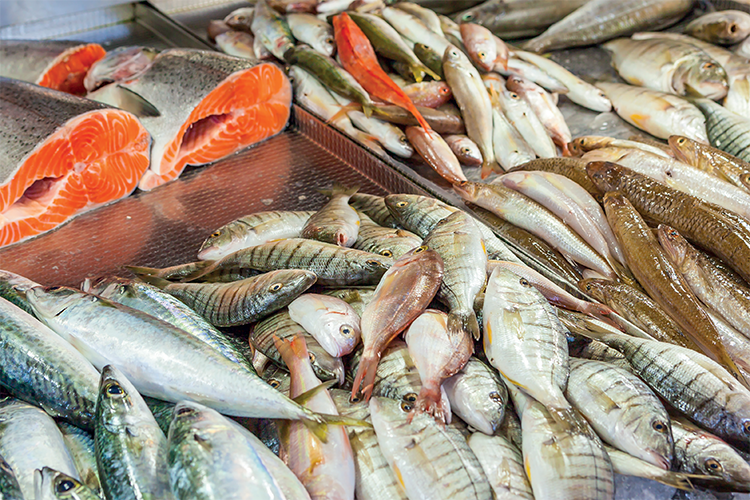
A new alternative
Since the Smart Protein project is aimed at developing sustainable future foods, it makes sense that we should be exploring plant-based fish – especially given the highly unsustainable nature of the global fishing industry. In preparing this article, we consulted with several Smart Protein partners, including the Good Food Institute, ProVeg International, the applied-research organization Fraunhofer, and the seafood companies Soguima and Thai Union.
As the plant-based market continues to grow at an accelerated pace, it might seem like alternatives to fish and seafood have been left behind. While this is true to some extent, it also means that the alt-fish sub-sector represents a key opportunity in the alt-food sector – since there is plenty of space for new products to enter the market and considerable space for growth. And, given the general enthusiasm about the plant-based space from both investors and consumers, it seems likely that plant-based fish is poised to catch up with its meat and dairy counterparts over the course of the next few years.
Looking at the alt-seafood sector globally, it’s clear that the industry is beginning to grow at an accelerated rate, particularly in terms of investment, with global investment in the sector growing from a quarter of a million US dollars in 2015 to 100 million dollars in 20211. In Germany, where the plant-based sector is particularly developed, Nielsen data for the two-year period ending October 2020 shows that plant-based fish had the highest growth rate of all plant-based food categories, growing by 623 percent over the two years. While this rapid growth is partially due to the small initial value of the sector, the rapid expansion of sales from €261 thousand in 2018 to €1.9 million in 2020 is not to be sniffed at, and gives an idea of the potential for further growth.
However, the selection of existing products is still very limited, consisting predominantly of fish fingers and crumbed fish burgers. The development and launch of plant-based analogues of fish fillets and other popular fish products are needed in order to satisfy unmet demand in the market. According to Kai-Brit Bechtold, Senior Research Scientist at ProVeg, “Consumer research suggests that there is a strong need to improve the ingredients and price points of these products.”
All of which suggests that plant-based fish presents a potentially lucrative business opportunity for those who can rise to the challenge of developing convincing fish analogues.
What do consumers want in plant-based fish products?
The Consumer Advice Centre in Hessen, Germany, recently did a survey exploring the consumption habits of 80 vegan and vegetarian consumers in relation to 20 plant-based-seafood products. The results revealed the following facts about the consumer experience of plant-based fish:
- A recognizable fish flavor is crucial, as is a chewing experience that is similar to conventional fish products.
- At present, most products do not meet the needs of consumers – they are either too processed or include too many additives, while also missing key components that are usually found in fish, such as omega-3 fatty acids, iodine, and Vitamin B12. Although products do contain protein, the ratio is generally not as high as with conventional fish.
- Furthermore, the price point of plant-based fish is too high – particularly for products that consumers do not find sufficiently satisfying. For example, breaded fish-substitute sticks cost 60 percent more than conventional fish sticks.
Of the 20 products that were tested, about two-thirds used highly processed soya and/or grains (such as rehydrated wheat protein) as protein sources. Half of the products used seaweed and/or algae to provide a fish flavor, while some products were augmented with additional flavors. Nearly all the products tested were missing fish-typical nutrients such as omega-3 fatty acids, iodine, and vitamin B12.
There is clearly a lot of room for improvement in this category, particularly in terms of ingredients and price. At the same time, there is a great deal of development in the sector. The Smart Protein project, together with its partners, is working hard to address these challenges.
Developing better plant-based fish products
Emanuel Guimarães is Director of Operations at the Portuguese seafood company Soguima and an active partner in the Smart Protein project. He had some useful insights about what is needed in order to bring plant-based fish into parity with conventional products.
Guimarães points out that it is likely that one of the reasons that seafood analogues have trailed behind in terms of market offerings is that fish and seafood have unique sensory characteristics. Generally speaking, these characteristics are the result of a combination of factors, ranging from volatile chemical compounds to the unique muscular structure of fish. But, says Guimarães: “While developing and launching more accurate seafood alternatives presents something of a challenge in terms of food technology, it also poses an appealing opportunity – one that will be highly profitable for those companies that crack alt-fish.”
One of the key challenges is to mask the off flavors and colors of the plant-based core ingredients, while achieving the right sensory characteristics. Yet, at the same time, consumers are increasingly demanding cleaner labels and less processed food. The challenge is to disguise off flavors and colors without using unpopular additives.
Color is key to consumer buy-in when it comes to alt-fish. Products that are substantially different in color to the product they are trying to replace are never going to convince consumers. Given that synthetic coloring already faces opposition from both consumers and regulatory agencies, one strategy is to try to mimic seafood that naturally has recognizable colors that are easy to achieve. Examples of fish with easily reproducible color palettes include tuna, salmon, fish roe, and cephalopods such as squid or octopus.
In terms of masking or minimizing the off flavors, there are a host of tried-and-tested techniques that are used in both conventional fish and other foods. These include processing methods such as pickling, salting, fermenting, and smoking, all of which can be used to improve and complement the flavor and texture of seafood analogues. It bears mentioning that while these traditional methods are sometimes modified or supplemented with modern synthetic additives or processes, in terms of consumer appeal, simpler is always better – especially in the European market, where levels of both consumer awareness and food regulation are particularly high.
The role of extrusion in developing plant-based fish
As with beef and poultry analogues, most plant-based fish products are likely to be produced using an extrusion process, in which the plant proteins are mixed with water and then blended and heated, before being extruded into their final form. The extrusion process involves numerous variables that can affect the texture, mouthfeel, and appearance of the finished product. These include temperature profile, screw design and speed, mass flow rate, the shape of the die, and moisture content, all of which can be adjusted separately to determine a particular product texture.
Creating convincing products requires a deep understanding and experience of the multiple interactions between raw materials and the extrusion process. With adjustments to the process, a large variety of shapes and textures can be generated, from soft and juicy to dense and high in gumminess. While there is a great deal of existing expertise around traditional extrusion inputs such as soya knowledge on the material behavior of more novel ingredients has to be generated from scratch, especially when new ingredients are mixed with another one in a multicomponent blend.
While there are challenges, extrusion allows for the processing of any plant-based raw material into a variety of fish and seafood alternatives, from soft fish steaks to dense tuna shreds to shrimps. Adjusting the variables in the extrusion process allows for the creation of plant-based versions of a wide range of conventional seafood products.
Finally, from a nutritional point of view, the gold standard of plant-based fish products should be a full replacement of all essential amino acids and vitamins that naturally occur in fish products. Since not all plant proteins contain all essential amino acids, a suitable approach to designing an optimal amino-acid profile for humans may be to combine different plant protein sources and process them as blends instead of as single ingredients.
A promising future for the sector
Despite the challenges faced by the sector and its slow early growth compared to other protein analogues, plant-based seafood looks set to soar in the coming years, particularly as sustainability concerns around conventional seafood continue to grow. The Smart Protein project, together with its partners, is committed to accelerating this growth by providing research and support wherever possible.
1 Good Food Institute (2021): State of the Industry Report. Alternative seafood. January 2020 – June 2021. Available at: https://gfi.org/wp-content/uploads/2021/07/2021-Seafood-State-of-the-Industry.pdf [Accessed: 10.09.2021]
(Invested capital includes accelerator and incubator funding, angel funding, seed funding, equity and product crowdfunding, early-stage venture capital, late-stage venture capital, private equity growth/expansion, capitalization, corporate venture, joint venture, convertible debt, and general debt completed deals. Note: Data has not been reviewed by PitchBook analysts.)
ProVeg International
 Peter Machen is International Communications Manager at ProVeg International, a food awareness organization working to transform the global food system by replacing animal-based products with plant-based and cultured alternatives. ProVeg works with decision-making bodies, companies, investors, the media, and the general public to help the world transition to a society and economy that are less reliant on animal agriculture and more sustainable for all humans, animals, and our planet. www.proveg.com
Peter Machen is International Communications Manager at ProVeg International, a food awareness organization working to transform the global food system by replacing animal-based products with plant-based and cultured alternatives. ProVeg works with decision-making bodies, companies, investors, the media, and the general public to help the world transition to a society and economy that are less reliant on animal agriculture and more sustainable for all humans, animals, and our planet. www.proveg.com
If you have any questions or are interested in investing in or developing plant-based seafood products, please contact Paloma Nosten – paloma.nosten@proveg.com
https://smartproteinproject.eu/